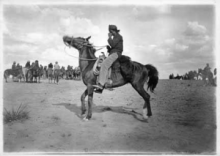Article
The horse was introduced to the Americas in the 1500s by the Spaniards. While the Spaniards prized the horse for the role it played in travel, exploration, and war, they at times left herds of horses in various locales, hoping that the animal would find ways to establish itself on the continents the Spanish were busily conquering. The horse proved very adaptable and found habitats to thrive in, especially in the Great Basin and Plains of North America. Native Americans, particularly along Spain's northern colonial frontier, emulated the Spaniards' use of the horse for transportation, hunting, labor, and sport, and soon out-mastered the Spanish horsemen in riding, training, and cultivating the beasts the Spanish so prized. The horse took on great significance to many indigenous communities, and in some cases was incorporated into origin stories as a gift from the gods. The horse also occupies a central role in many mythologized frontier narratives about the Western and Southwestern regions of the United States.
"Navajo man on horse circa 1901," photograph by William H. Simpson.
Manuscripts
A01 The Blessing Way (01-07) p. 41
A01 The Blessing Way (01-07) p. 59
A01 The Blessing Way (01-07) p. 62
A01 The Blessing Way (01-07) p. 70
A01 The Blessing Way (01-07) p. 72
A01 The Blessing Way (01-07) p. 93
A01 The Blessing Way (01-07) p. 94
A01 The Blessing Way (01-07) p. 95
A01 The Blessing Way (01-07) p. 97
A01 The Blessing Way (01-07) p. 117
A01 The Blessing Way (01-07) p. 119
A01 The Blessing Way (01-07) p. 122
A01 The Blessing Way (01-07) p. 126
A01 The Blessing Way (01-07) p. 127
A01 The Blessing Way (01-07) p. 166
A01 The Blessing Way (01-07) p. 177
A01 The Blessing Way (01-07) p. 180
A01 The Blessing Way (01-07) p. 181
A01 The Blessing Way (01-07) p. 182
A01 The Blessing Way (01-07) p. 187
A01 The Blessing Way (01-07) p. 195
A01 The Blessing Way (01-07) p. 221
A01 The Blessing Way (01-07) p. 222
A01 The Blessing Way (01-07) p. 227
A04 Dance Hall of the Dead (04-06) p. 55
A04 Dance Hall of the Dead (04-06) p. 56
A04 Dance Hall of the Dead (04-06) p. 57
A04 Dance Hall of the Dead (04-06) p. 58
A04 Dance Hall of the Dead (04-06) p. 78
A04 Dance Hall of the Dead (04-06) p. 85
A04 Dance Hall of the Dead (04-06) p. 89
A04 Dance Hall of the Dead (04-06) p. 91
A04 Dance Hall of the Dead (04-06) p. 96
A05 Listening Woman (02-13), p. 41
A05 Listening Woman (02-13), p. 46
A05 Listening Woman (02-13), p. 153
A05 Listening Woman (02-13), p. 156
A07 The Dark Wind (04-06), p. 19
A07 The Dark Wind (04-06), p. 29
A07 The Dark Wind (04-06), p. 51
A07 The Dark Wind (04-06), p. 63
A07 The Dark Wind (04-06), p. 68
A07 The Dark Wind (04-06), p. 118
A07 The Dark Wind (04-06), p. 139
A07 The Dark Wind (04-06), p. 171
A07 The Dark Wind (04-06), p. 219
A08 The Ghostway (05-03), p. 36
A08 The Ghostway (05-03), p. 60
A08 The Ghostway (05-03), p. 61
A08 The Ghostway (05-03), p. 62
A08 The Ghostway (05-03), p. 63
A08 The Ghostway (05-03), p. 64
A08 The Ghostway (05-03), p. 65
A08 The Ghostway (05-03), p. 70
A08 The Ghostway (05-03), p. 71
A08 The Ghostway (05-03), p. 172
A08 The Ghostway (05-03), p. 201
A08 The Ghostway (05-03), p. 202
A08 The Ghostway (05-03), p. 206
A08 The Ghostway (05-03), p. 207
A08 The Ghostway (05-03), p. 208
A08 The Ghostway (05-03), p. 209
A08 The Ghostway (05-03), p. 210
A08 The Ghostway (05-03), p. 211
A08 The Ghostway (05-03), p. 225
References
Cothran, Gus E.
N.d. Horse. Encyclopædia Britannica Online. http://www.britannica.com/animal/horse,
accessed November 18, 2015.

